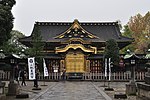The University Art Museum, Tokyo University of the Arts
1999 establishments in JapanArt museums and galleries in TokyoArt museums established in 1999Buildings and structures in TaitōUeno Park ... and 1 more
University museums in Japan

The University Art Museum, Tokyo University of the Arts (東京芸術大学大学美術館, Tōkyō Geijutsu Daigaku Daigaku Bijutsukan) opened in Ueno Park, Taitō, Tokyo, Japan, in 1999, replacing the University's former Art Museum. The collection, numbering some thirty thousand works of art, includes twenty-three National Treasures and Important Cultural Properties, among them a Nara period scroll of the Illustrated Sutra of Cause and Effect and paintings by Asai Chū, Harada Naojirō, Hashimoto Gahō, Kanō Hōgai, Ogata Kōrin, Takahashi Yuichi, and Uemura Shōen.
Excerpt from the Wikipedia article The University Art Museum, Tokyo University of the Arts (License: CC BY-SA 3.0, Authors, Images).The University Art Museum, Tokyo University of the Arts
Taito
Geographical coordinates (GPS) Address Website Nearby Places Show on map
Geographical coordinates (GPS)
| Latitude | Longitude |
|---|---|
| N 35.719199 ° | E 139.771897 ° |
Address
東京藝術大学大学美術館
110-8714 Taito
Japan
Open on Google Maps









